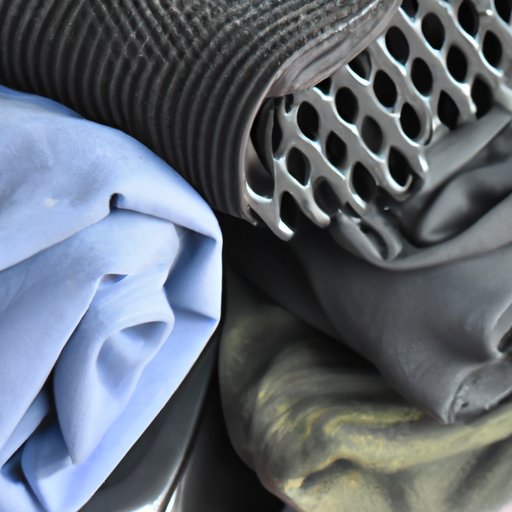How to Get Static Out of Clothes: Expert Tips and Tricks
Static cling is a common problem that many people experience when doing laundry. It can be frustrating to put on a fresh set of clothes only to find your outfit sticking to you with every movement. Not only is static cling uncomfortable, but it can also be embarrassing in public. Fortunately, there are several ways to prevent static buildup on your clothes. In this article, we’ll explore the most effective ways to get static out of clothes so that you can enjoy comfortable, cling-free outfits!
Use Dryer Sheets
Dryer sheets are a popular and effective way to get static out of clothes. These small sheets of scented fabric contain positively charged ingredients that help to neutralize the negative static charge that builds up on fibers during the drying process. By reducing the static charge, dryer sheets can help to prevent clothes from clinging to each other and sticking to your body.
To use dryer sheets effectively, simply toss one or two sheets into the dryer with your clothes before drying. For maximum effectiveness, be sure to use the correct number of sheets (based on the size of your load) and place them directly on top of your clothes. Avoid overcrowding the dryer, as this can reduce the effectiveness of the dryer sheets.
Add Vinegar to the Wash Cycle
Vinegar is another effective way to get static out of clothes. This common household item has acidic properties that help to eliminate static electricity. By adding vinegar to the wash cycle, you can help to prevent static buildup on your clothes and keep them clean and fresh.
To add vinegar to the wash cycle, simply pour a half cup of white vinegar into the fabric softener dispenser of your washing machine. Alternatively, you can add the vinegar directly to the wash water during the rinse cycle. Be sure to use white vinegar – other types of vinegar can stain your clothes or leave an unpleasant odor.
Use a Humidifier
Dry air can contribute to static cling on clothes. When the air is dry, it lacks the moisture that helps to disperse electrical charges throughout the environment. This can cause static buildup on clothes, especially during the winter months when indoor heating can dry out the air in your home. To combat dry air and reduce static cling, consider using a humidifier in your home.
A humidifier releases moisture into the air, which can help to reduce the static charge on your clothes. By keeping the air in your home balanced and moisturized, you can prevent static buildup and keep your clothes fresh and clean. Be sure to follow the manufacturer’s instructions for your specific humidifier model.
Line Dry Clothes
Line drying clothes is a great way to avoid static cling altogether. When you line dry your clothes, the natural airflow helps to dissipate any static buildup that may occur during the washing process. Line drying is also an environmentally friendly option, as it saves energy and reduces your carbon footprint.
If you don’t have access to an outdoor clothesline, consider using a drying rack indoors. Drying racks can be set up in any room of your home and provide a convenient way to dry clothes without the need for a dryer. Simply lay your clothes flat or hang them on the rack, and wait for them to dry naturally.
Reduce Drying Time in the Dryer
Longer drying times can increase static buildup on your clothes. When clothes spend too much time tumbling around in a dryer, they can develop a significant static charge. To reduce the amount of static buildup on your clothes, try reducing the drying time in your dryer.
One way to reduce drying time is to make sure that your dryer is properly ventilated. A dryer with a clogged vent can take longer to dry clothes, thus increasing the amount of static that may build up. Be sure to clean your dryer vent regularly to ensure that air can circulate properly.
Use Aluminum Foil Balls
Aluminum foil balls are a simple and affordable way to eliminate static cling on your clothes. These small balls of aluminum foil work by giving your clothes a boost of static-neutralizing power. By tumbling around in the dryer, the aluminum foil balls help to disperse the electrical charge that builds up on fibers during the drying process.
To make aluminum foil balls, simply crumple up a sheet of aluminum foil into a ball about two inches in diameter. Use two to three balls per load in the dryer, and remove and replace them after every few cycles. This will ensure that they stay effective at reducing static cling on your clothes.
Switch to Natural Fabrics
If you’re still experiencing static cling on your clothes, it may be time to switch to natural fiber clothing. Synthetic fabrics (such as polyester and nylon) are known to generate more static electricity than natural fibers (such as cotton and wool). By focusing on natural fiber clothing, you can reduce the potential for static buildup on your clothes.
When selecting natural fiber clothing, look for items made from cotton, wool, silk, or linen. These materials are breathable, comfortable, and naturally static-resistant. Avoid synthetic blends, which may contain a higher percentage of polyester or nylon fibers.
Conclusion
Static cling on clothes can be a frustrating problem, but it’s not impossible to solve. By using the tips and tricks presented in this article, you can effectively reduce static buildup on your clothes and enjoy comfortable, cling-free outfits. Whether you choose to use dryer sheets, vinegar, humidifiers, or other methods, be sure to experiment and find the best solution for your specific needs.
